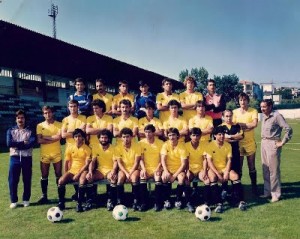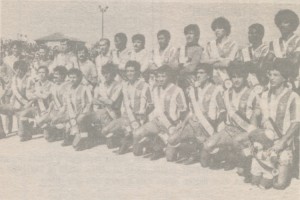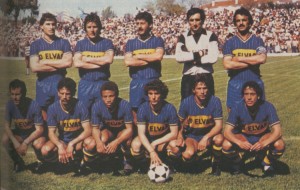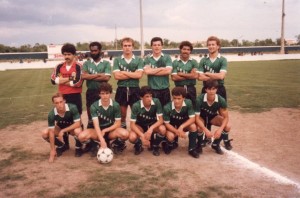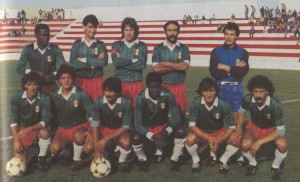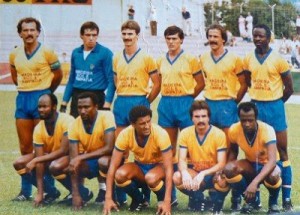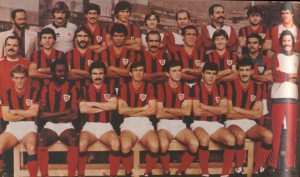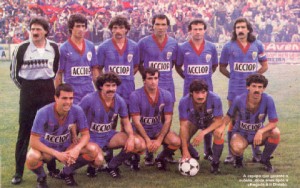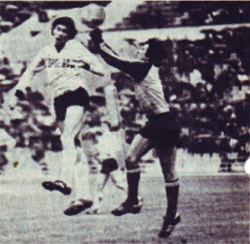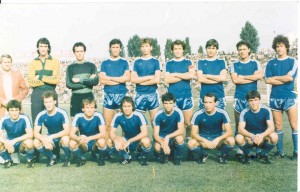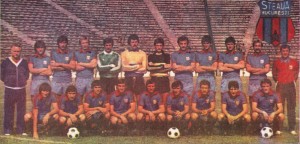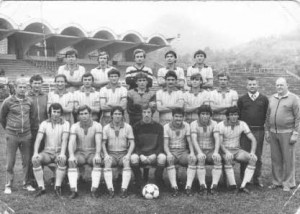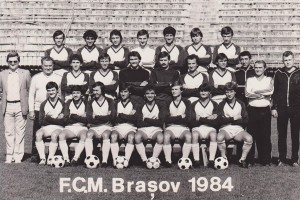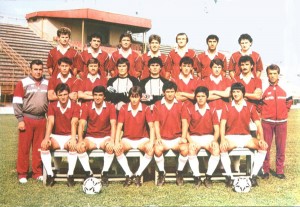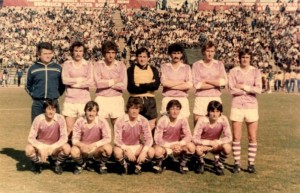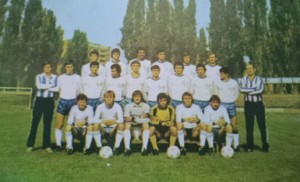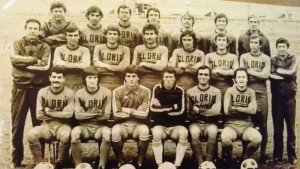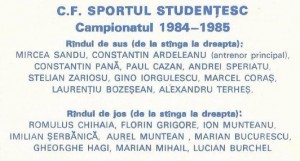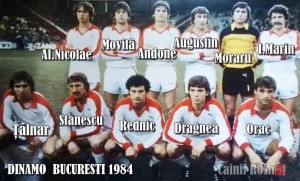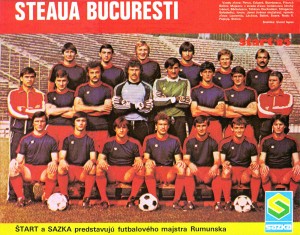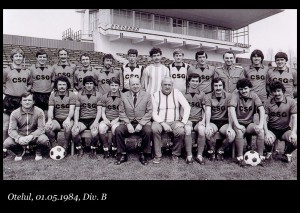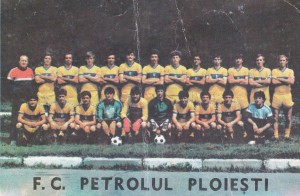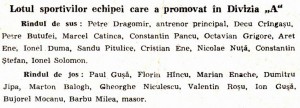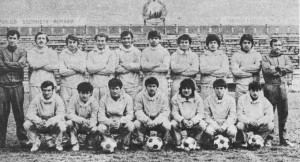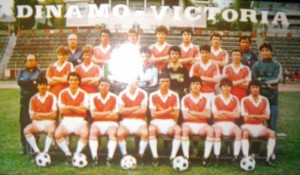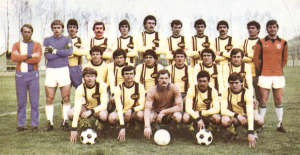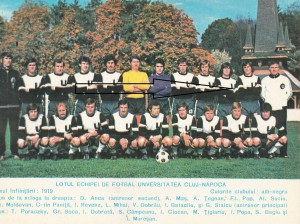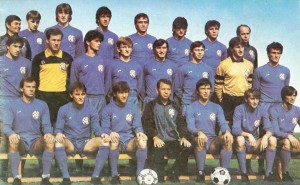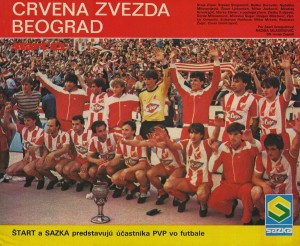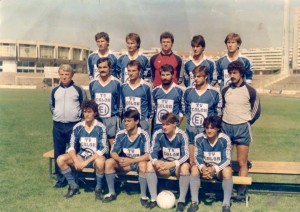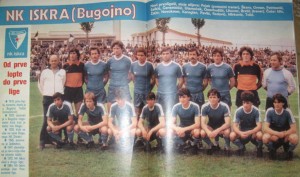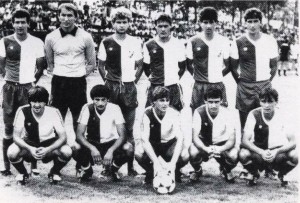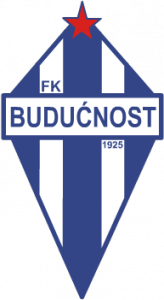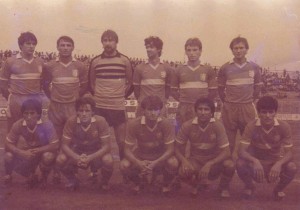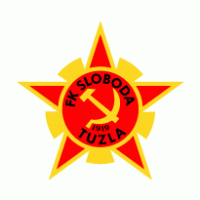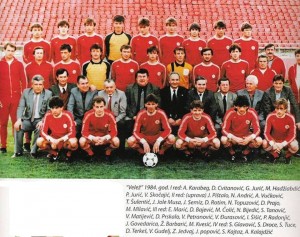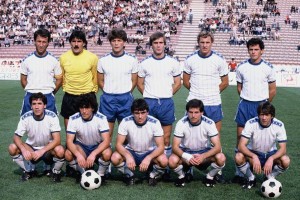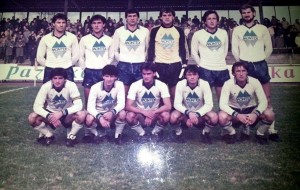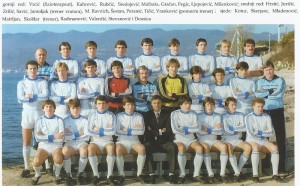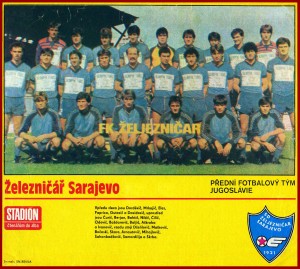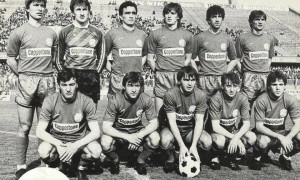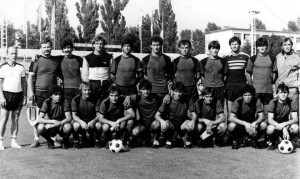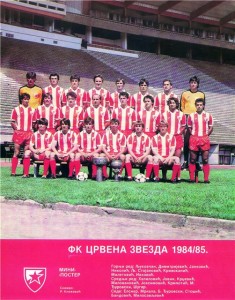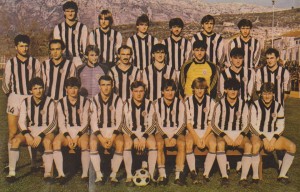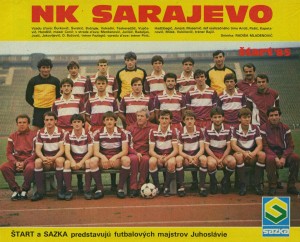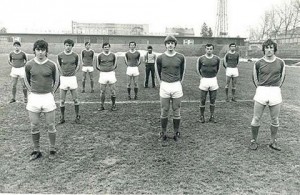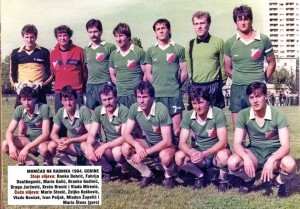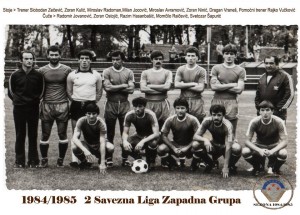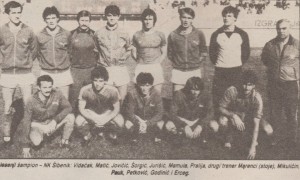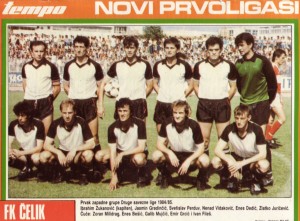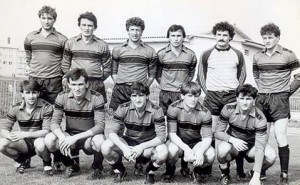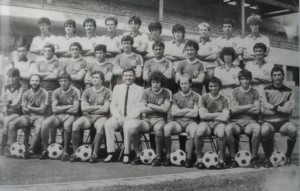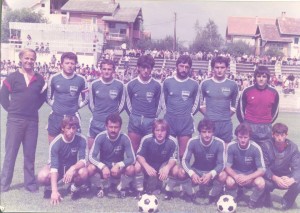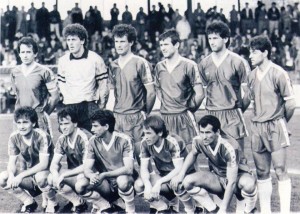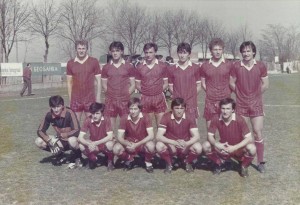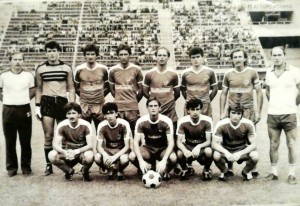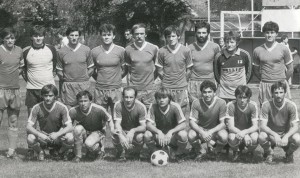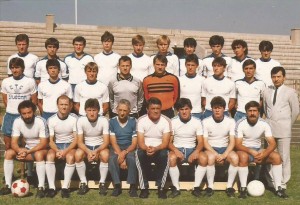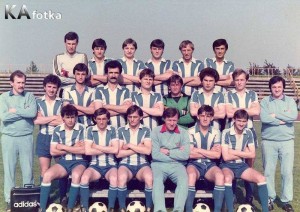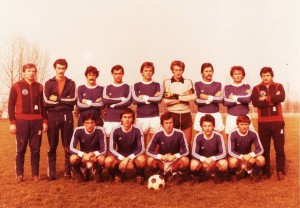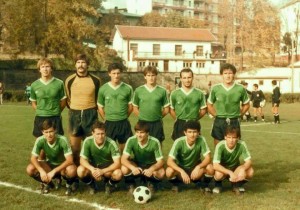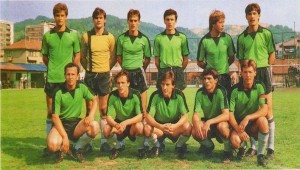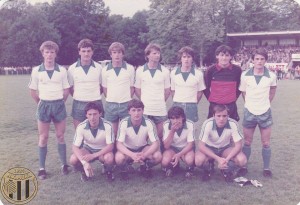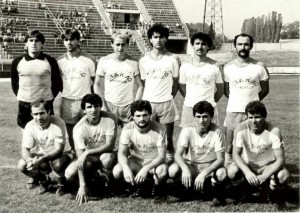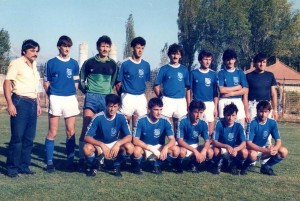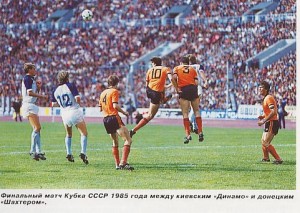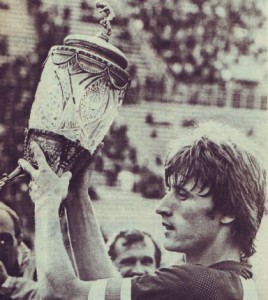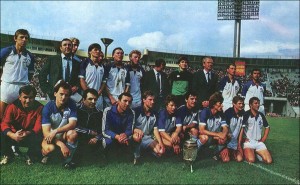First Division. First of all, rules. A limit of 10 ties and no points for those ties above the limit. Five teams lost points because of the rule – Kairat (Alma-Ata) most of all, 3 points. However, most teams were ‘wise’ and lost points were not only few, but did not affect final standings. Face-to-face results determined positions in case of equal points and only if teams were still equal goal-difference was applied – the last point saved Dinamo (Moscow). The coming reduction of the league made the battle for survival most important – and also justified the reduction, for one round before the end of the championship, for 8 clubs were in danger of relegation at that point. The last two were directly relegated; the 15th and 16th teams were going to promotion/relegation play-off against the winners of Second Division. At the top end of the table the battle ended a bit earlier, when Dinamo (Kiev) secured the title. It was not overwhelming victory, but it was a bit surprising one – Dinamo was not playing very good in the recent years and was not expected to improve suddenly. But they did, although not at their peak yet. Spartak (Moscow) proved to be eternal loser – once again, the most they could do was to finish 2nd. The recent provincial champions proved to be just good – not great – and thus unable to repeat their successes. The decline of Dinamo (Moscow), Ararat (Erevan), and Dinamo (Tbilisi) continued and now it looked like Shakhter (Donetzk) was joining the sorry bunch. One irritating point was the artificial pitch used in Moscow to which visitors had no way to adapt – the pitch gave enormous advantage to the Moscow teams and was even decisive on some occasions, but complains fell on death ears.
SKA (Rostov) was the hopeless outsider of the championship – last with 21 points. If anything, they confirmed the massive decline of Army clubs – there will be no such team in the next championship.
Fakel (Voronezh) was 17th with 27 points. They did what they could, but were generally expected to be relegated and did not disappoint – they and SKA were directly relegated.
The big drama was above the last two – the dangerous spots had to be avoided and that was decided in the last round, where sheer will seemingly helped, for direct opponents met. Ararat and Shakhter ended in a 3-3 tie. The clash between Neftchi and Dinamo (Moscow) ended scoreless. And Chernomoretz lost at home to Kairat 0-1. After that…
Neftchi (Baku) was 16th with 28 points and going to promotion/relegation play-off.
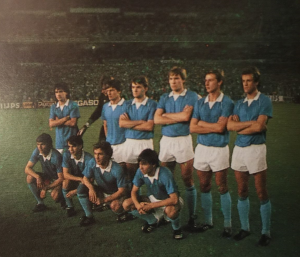
Chernomoretz (Odessa) was 15th with 29 points. What a plunge down… this is picture of the team against Real (Madrid), playing for the UEFA Cup. The previous season was great and now – going to promotion/relegation play-off. Chernomoretz was a bit unlucky, for they were 15th only because of worse goal-difference. Then again… who lost its most important home game of the season?
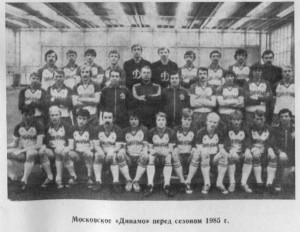
Dinamo (Moscow) barely survived – 14th with 29 points. Better goal-difference helped them, but, frankly, it could have been just fine if they were relegated. The decline was seemingly endless… perhaps a relegation would have shaken them from the stupor.
Ararat (Erevan) – 13th with 30 points. Their last match may have been fixed – the 3-3 tie with neighbours Shakhter gave neither team a point and it looked like a gamble: keep the already earned 30 points and hope those below to lose their own matches. It worked… Dinamo (Moscow) got 1 point and Chernomoretz – 0. However, if those clubs won, Ararat was going down. And if Ararat won, then Shakhter was in danger… so, suspect tie. It kept Shakther safe and Ararat almost safe.
Shakther (Donetzk) – 12th with 30 points, but, curiously, with positive goal-difference. It looked like they gave up on the championship and concentrated on the Cup, but such argument is lame: the Cup final was played at mid-season. Rather, Shakhter betrayed signs of coming crisis.
Torpedo (Kutaisi) looked good in the final table – 11th with 31 points. But that only thanks to 2-1 home victory in the last round – Dinamo (Kiev) had nothing to play for and was generous. Torpedo survived, that was the reality. However, if Dinamo still had to fight for the title… Torpedo could have been down to promotion/relegation play-offs.
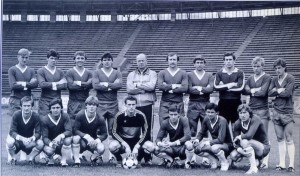
Metallist (Kharkov) – 10th with 31 points. Nothing special this season, but managed to survive a bit earlier than most and the last round did not matter to them.
Kairat (Alma-Ata) – 9th with 32 points. Thanks to their last minute victory in Odessa. Happy survivors, but the only thing to say about them was that they lost most points to 10-ties-limit rule.
Dinamo (Tbilisi) – 8th with 32 points. Decline was the word.
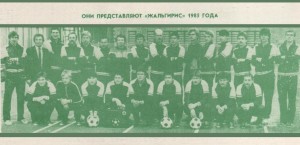
Zhalgiris (Kaunas) – 7th with 32 points. Not that many points, but this was a bright team, settling comfortably in the top league and gaining experience. One of the noticeable teams, expected to climb higher in the future.
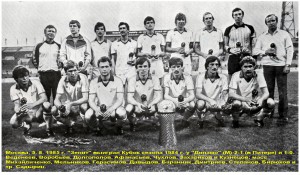
Zenit (Leningrad) – 6th with 35 points. Nobody expected them to win a second title, but the team disappointed in the European Champions Cup and generally it was felt they underperformed. First row from left: Vedeneev, Vorobyov, Dolgopolov, Afanassyev, Chukhlov, Zakharikov, Kuznetzov.
Standing: Mikhaylichenko – masseur, Melnikov, Gerassimov, Davydov, Barannik, Dmitriev, Stepanov, Biryukov, Sadyrin – coach.
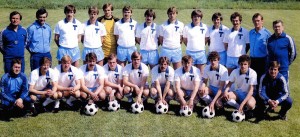
Torpedo (Moscow) – 5th with 36 points. The best of the ‘lower’ teams, for the 4 teams above were in their own separate category. Crouching form left: A. Petrov – masseur, Dozmorov, Prigoda, Gostenin, Redkous, Petrakov, Petrenko, A. Solovyev, N. Sarychev, Yu. Sarychev, Filatov – assistant coach.
Second row: Ivanov – coach, Zhendarev – administrator, Susloparov, Buryak, Sarychev, Pivtzov, Polukarov, Kobzev, Zhupikov, N. Vassilyev, V. Kruglov, Proyaev – doctor, Zolotov – team chief.
Torpedo was criticized – along with Dnepr and Dinamo (Kiev) – for passive play and disrespect for the game and the public and the accusations were true, but so what? There was almost nothing to play for near the end of the season – Torpedo was safe and up in the table, but the very top was unreachable. Nothing new, in their case, for the club maintained good squad, but generally of second-stringers, some of them aging.
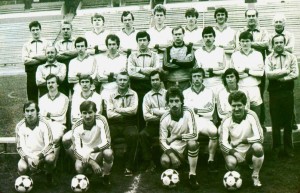
Dinamo (Minsk) – considered one of the candidates for the title, as all recent champions, but not an outstanding leader. Dinamo had limited options, like most provincial club, and it was almost a miracle they were able to keep their stars. But it was pretty much the same team which won the title a bit back – may be no worse, but certainly no better. No great new recruits. 4th with 41 points – mostly because of weak finish, but their most important losses came against direct opponents playing home games on artificial pitch. This was too much Dinamo, used to grass.
Top row from left: Aleksandr Chernukho – masseur, Aleksandr Gorbylev, Sergey Gorlukovich, Lyudas Rumbutis, Aleksandr Metlitzky, Andrey Sosnitzky, Viktor Sokol, Vassily Dmitrakov – doctor, Mikhail Tzeytin – assistant coach.
3rd row: Ivan Savostikov – assistant coach, Yury Trukhan, Aleksandr Kisten, Mikhail Vergeenko – assistant coach, Ivan Zhekyu, Andrey Zygmantovich, Andrey Shalimo, Leonid Vassilevsky – administrator.
2nd row: Yury Kurnenin, Viktor Yanushevsky, Leonid Garay – team chief, Veniamin Arzamastzev – coach, Igor Gurinovich, Viktor Shishkin.
Front row: Georgy Kondratyev, Sergey Gotzmanov, Sergey Aleynikov, Sergey Borovsky.
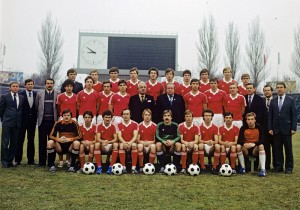
Dnepr (Dnepropetrovsk) – 3rd with 42 points. Perhaps the most promising team at the time, but hardly stronger than the other leading teams. One of the teams accused of disrespecting the sport and the fans this season. What Dnepr was not accused of was their super-physical way of playing – very often they were dangerous, but somehow the truly ugly side of their football never came under criticism in USSR.
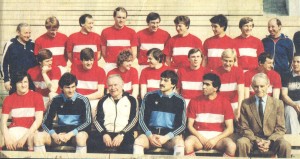
Spartak (Moscow) – 2nd with 46 points. This was painfully familiar trend: every year Spartak was considered prime favorite for the title and every year they failed. The most consistent Soviet team, but second-best. Their coach Konstantin Beskov blamed recruitment difficulties and perhaps he was right – at best, Spartak was able to match the quality of exiting players with those of newcomers. No more than that, so there was good regular team – good, but almost always with a weak post or two – and rather insignificant group of reserves. Why Spartak, considered not only leading team, but the one playing the most exciting football in the country, was unable to attract top-level talent could be asked of the coaching staff – were they blind? After the end of the season 3 leading players left and none similar to them arrived.
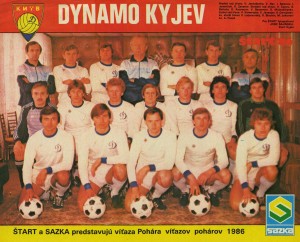
Dinamo (Kiev) was the championship with 20 wins, 8 ties, and 6 losses. 64-26 and 48 points. Easy to shrug shoulders today and say ‘who else’, but it was surprise victory in 1985. Dinamo had tough spell in recent years, so they were not seen as top favorite. Further, the squad was unusually short for Lobanovsky’s team – strong regulars, but nobody worth mentioning behind them. Further: frictions between coach and players were no longer just dark rumors, but public knowledge – Leonid Buryak, for instance, was not shy at all and did not hide why he went Torpedo (Moscow) from journalist. Tremors of this period can still be heard today – recently a player, who left Dinamo, spoke of 1983 in this way: ‘talent sat on the bench and Lobanovky’s pets were on the pitch’. Tense relations were seen as part of Dinamo’s recent failures. And finally Chanov broke his arm and missed a considerable chunk of the season – just as Dinamo finally got decent goalkeeper. So, Dinamo was seen as one of leaders, but no stronger than Spartak, Dnepr, Dinamo (Minsk), and Zenit. Unlikely winner. And it was not an easy victory, perhaps helped a bit by inconsistent performance and various weaknesses of the rivals. It was essentially the work of tied short team – a cluster of 12-13 regulars, supported by typical Dinamo group of reliable second-stringers, 3 or 4, who would never be regulars, but just support for a few years and then dismissed. 14 players really played this season – V. Khlus, the author of the accusation mentioned above, appeared only twice! As a whole, Dinamo was not exactly an impressive team, but they stepped up a bit near the end of the season – especially in their European games, and at least the foundation of the great football they played in 1986 was laid. Well, 11th title. Difficult one, yes, but compared to the rivals, Dinamo had superior team – well-rounded, slightly deeper than what others had, and the top players of USSR were really here. Dinamo was also the only club having no problems of recruitment – they took anybody they wanted, which was mainly robbing the other Ukrainian clubs of their stars – Dnepr was already on the list: they had goalscoring machine, Oleg Protassov, and Dinamo was not going to leave him there.
